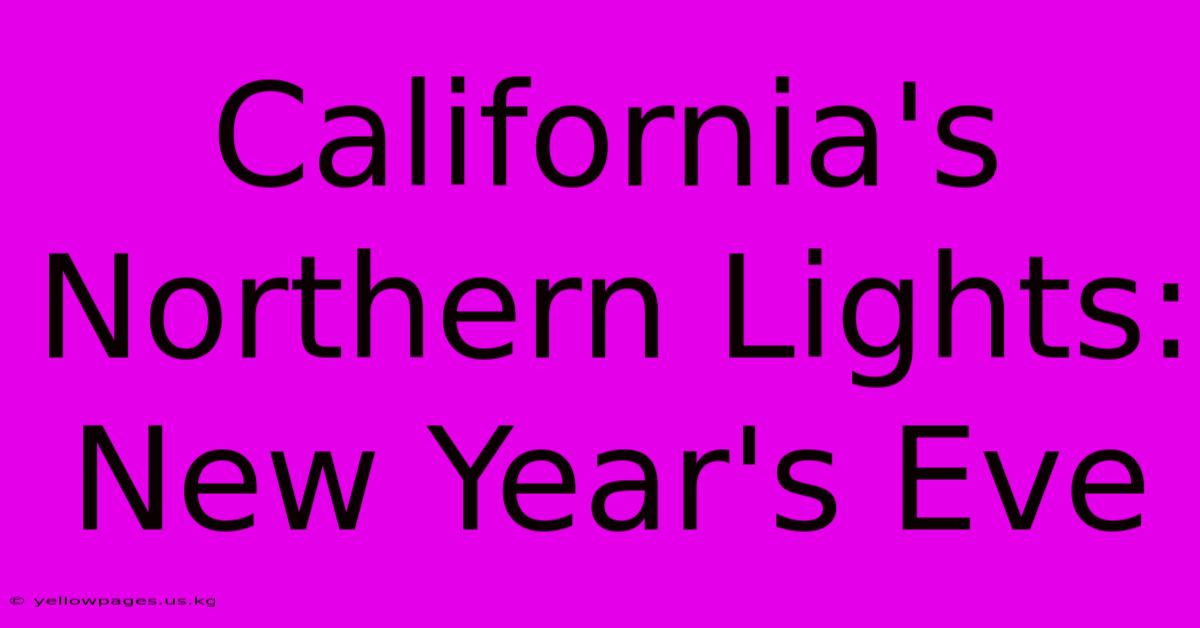California's Northern Lights: New Year's Eve

Discover more detailed and exciting information on our website. Click the link below to start your adventure: Visit Best Website trendingnews.us.kg. Don't miss out!
Table of Contents
California's Northern Lights: A New Year's Eve Spectacle (or, How to Chase the Aurora in the Golden State)
Dreaming of witnessing the magical aurora borealis, but think you need to trek to Alaska or Scandinavia? Think again! While California isn't known for its Northern Lights displays like its northern neighbors, a potent geomagnetic storm combined with optimal viewing conditions could theoretically result in a rare, albeit faint, sighting of the aurora in the state's northernmost regions. This article explores the possibility, the best viewing locations, and how to maximize your chances of experiencing this once-in-a-lifetime New Year's Eve event.
Understanding the Aurora Borealis and California's Chances
The aurora borealis, or Northern Lights, is a natural light display in the sky, predominantly seen in high-latitude regions. It's caused by charged particles from the sun colliding with atoms in the Earth's atmosphere. The intensity and visibility of the aurora are directly related to solar activity.
California's low latitude makes witnessing the aurora extremely unlikely under normal solar conditions. The aurora typically appears at high latitudes because the Earth's magnetic field funnels the charged particles towards the poles. However, during periods of intense geomagnetic storms—caused by powerful solar flares—the aurora oval expands, potentially reaching lower latitudes.
So, can you see the Northern Lights in California? The short answer is: Maybe. But it's highly improbable. It requires a perfect storm of conditions: an exceptionally strong geomagnetic storm (Kp7 or higher on the planetary K-index), clear, dark skies, and minimal light pollution. New Year's Eve offers a slim chance, as it's possible to have a powerful solar event around this time.
Where to Look for California's Northern Lights
If you're determined to chase this celestial wonder, focusing your efforts on the following areas will maximize your chances:
1. Northern California's Darkest Skies:
- Mount Shasta: Its high altitude and relative remoteness offer a better chance of seeing faint auroral displays, far from city lights.
- Lassen Volcanic National Park: Similar to Mount Shasta, the park's dark skies and high elevation could offer a slight advantage.
- Modoc Plateau: This high-desert region boasts some of the darkest skies in California, making it a potential spot for aurora viewing, though still highly unlikely.
2. Minimizing Light Pollution:
Remember, even with a strong geomagnetic storm, light pollution will severely hamper your chances. Choose locations far from cities and towns. Use a light pollution map to identify the darkest areas.
Tips for Aurora Hunting on New Year's Eve
- Monitor Space Weather Forecasts: Keep an eye on websites and apps that provide real-time space weather updates, including the planetary K-index. A high Kp value is essential.
- Check the Weather Forecast: Clear skies are crucial. Cloudy conditions will completely obscure any auroral display.
- Pack Appropriately: Even in California, high-altitude locations can get extremely cold, especially at night. Dress warmly in layers.
- Bring Binoculars or a Telescope: These can help enhance the faint glow of the aurora if it's visible.
- Be Patient: Even if conditions are favorable, the aurora might be faint and fleeting. Be prepared to wait and observe for extended periods.
- Manage Expectations: Let's be realistic—the chances of seeing a vibrant aurora borealis in California are extremely low. However, the experience of trying to spot this celestial event under the dark California sky can be a unique and memorable New Year's Eve adventure.
Conclusion: A New Year's Eve Gamble
While seeing the Northern Lights in California is a long shot, the possibility alone is exciting. By following these tips and monitoring space weather, you might just be rewarded with a truly unforgettable and rare New Year's Eve celestial spectacle. Even if the aurora remains elusive, you'll have experienced the thrill of the chase under the California stars. Happy hunting!

Thank you for visiting our website wich cover about California's Northern Lights: New Year's Eve. We hope the information provided has been useful to you. Feel free to contact us if you have any questions or need further assistance. See you next time and dont miss to bookmark.
Featured Posts
-
College Football Playoff Bracket
Jan 01, 2025
-
Citrus Bowl Refs Illinois South Carolina Game
Jan 01, 2025
-
Bedard To Star In 2025 Winter Classic
Jan 01, 2025
-
Alabama Michigan Score Crimson Tide Loss
Jan 01, 2025
-
Baylor Lsu Prediction Who Wins
Jan 01, 2025
